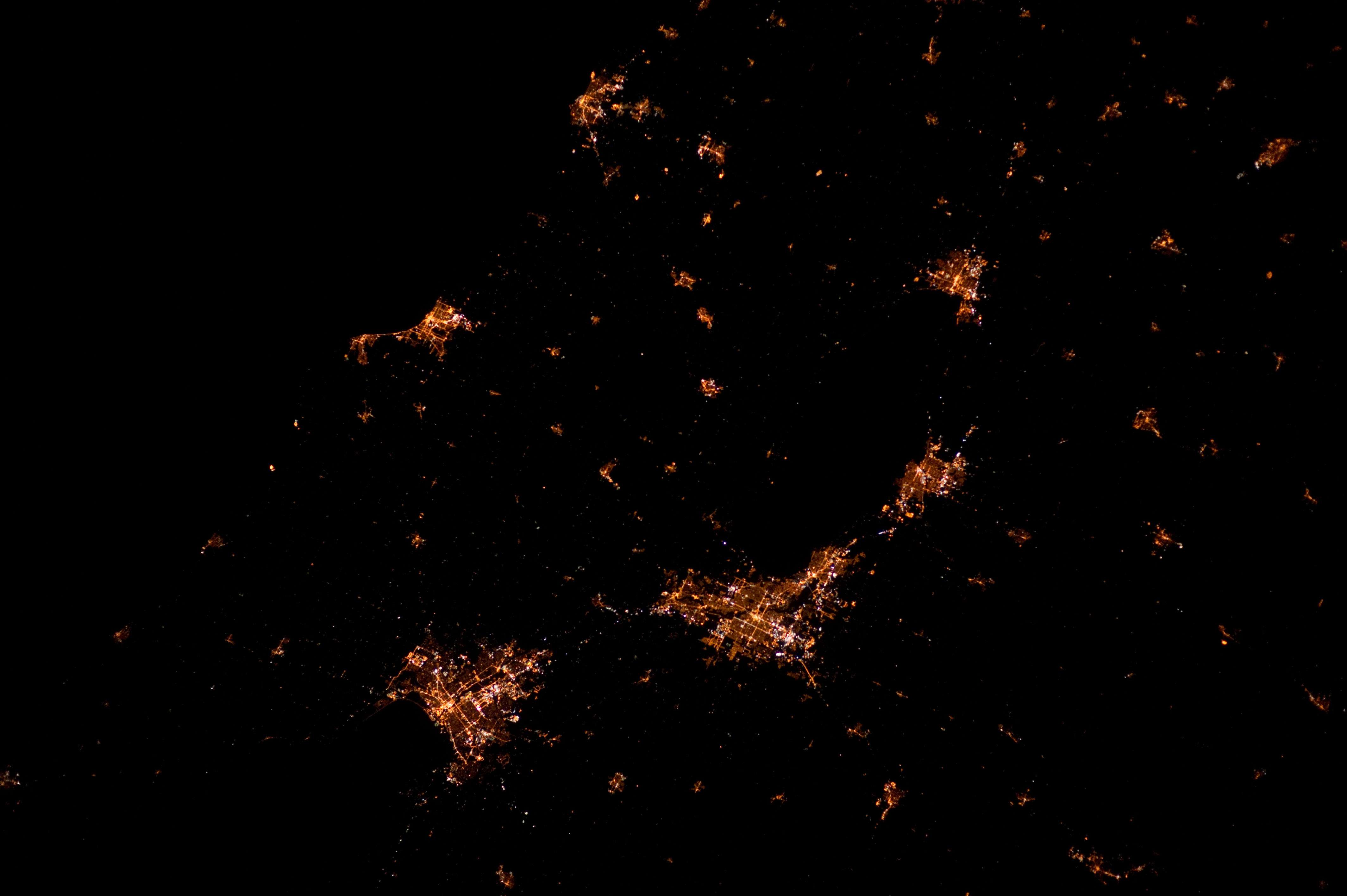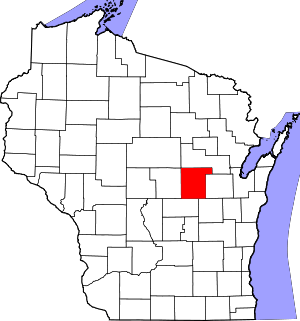Waupaca, Wisconsin
Waupaca is a city in and the county seat of Waupaca County in the U.S. state of Wisconsin. The population was 6,069 at the 2010 census. The city is believed to be named after Sam Waupaca (or Chief Wapuka) of the Potawatomi tribe.
Waupaca | |
|---|---|
City | |
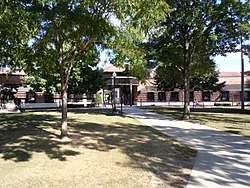 Waupaca City Hall/Library Building | |
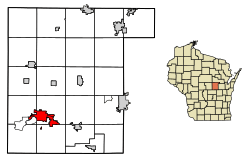 Location of Waupaca in Waupaca County, Wisconsin. | |
 Waupaca Location within the state of Wisconsin | |
| Coordinates: 44°21′18″N 89°4′54″W | |
| Country | United States |
| State | Wisconsin |
| County | Waupaca |
| Area | |
| • Total | 8.21 sq mi (21.27 km2) |
| • Land | 7.92 sq mi (20.51 km2) |
| • Water | 0.29 sq mi (0.75 km2) |
| Population | |
| • Total | 6,069 |
| • Estimate (2019)[3] | 5,969 |
| • Density | 753.66/sq mi (291.01/km2) |
| Time zone | UTC-6 (Central (CST)) |
| • Summer (DST) | UTC-5 (CDT) |
| ZIP code | 54981 |
| Area code(s) | 715 & 534 |
| FIPS code | 55-84375 |
| Website | www.cityofwaupaca.org |
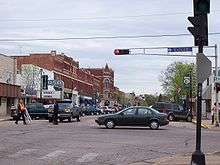

The city is located mostly within the Town of Waupaca, and it is politically independent of the town. A portion extends west into the adjacent Town of Farmington, and there is also a noncontiguous area of the city in the Town of Lind to the south. The city is divided into natural areas, city areas, and industrial areas.
History
Native American mound builders lived in the area prior to European settlement. At one time there were 72 earthwork mounds in the area, some of them ancient prehistoric works.[4]
Before the 19th century, this area was occupied by the historic Menominee and Potowatomi tribes, both of whom spoke Algonquian languages. They had long traded with French colonists who traveled here from New France (Quebec).
European Americans began to settle here in the mid-19th century as part of their westward movement from New England and New York, sometimes after settling for a period in Ohio or Indiana. In June 1849 Capt. Augustus Hill Sr. and his sons settled at a small waterfall along the Waupaca River, beginning what became known as the city of Waupaca. The settlement was named either for the Menominee term waubuck seba, meaning "pale water", or after Sam Wapuka, a local Potowatomi man who was also known as Chief Waupaca.[5]
Waupaca was incorporated as a village on May 4, 1857 by an act of the Wisconsin State Legislature.[6] This act was repealed on April 7, 1862,[7] but revived on June 17 of the same year.[8] Waupaca was incorporated as a city by the legislature on March 5, 1875.[9]
Beginning in the 1960s and continuing to the present, the city has expanded its population and area through annexation.
Geography
Waupaca is located at 44°21′17″N 89°4′54″W (44.354922, -89.081775).[10]
According to the United States Census Bureau, the city has a total area of 8.11 square miles (21.00 km2), of which, 7.82 square miles (20.25 km2) is land and 0.29 square miles (0.75 km2) is water.[11]
Transportation
| U.S. 10 Eastbound US 10 routes to Appleton. Westbound, US 10 routes to Stevens Point. | |
| WIS 22 travels north to Clintonville and south to Wild Rose. | |
| WIS 49 routes northbound to Iola. Southbound, it runs concurrent with US 10 and routes to Berlin. | |
| WIS 54 travels east to New London and west to Wisconsin Rapids, Wisconsin. |
From 1899 to 1926, streetcar service was provided by the Waupaca Electric Light and Railway Company.
Airport
- KPCZ - Waupaca Municipal Airport
Demographics
| Historical population | |||
|---|---|---|---|
| Census | Pop. | %± | |
| 1880 | 1,392 | — | |
| 1890 | 2,127 | 52.8% | |
| 1900 | 2,912 | 36.9% | |
| 1910 | 2,789 | −4.2% | |
| 1920 | 2,839 | 1.8% | |
| 1930 | 3,131 | 10.3% | |
| 1940 | 3,458 | 10.4% | |
| 1950 | 3,921 | 13.4% | |
| 1960 | 3,984 | 1.6% | |
| 1970 | 4,342 | 9.0% | |
| 1980 | 4,472 | 3.0% | |
| 1990 | 4,957 | 10.8% | |
| 2000 | 5,676 | 14.5% | |
| 2010 | 6,069 | 6.9% | |
| Est. 2019 | 5,969 | [3] | −1.6% |
| U.S. Decennial Census[12] | |||
2010 census
As of the census[2] of 2010, there were 6,069 people, 2,702 households, and 1,356 families residing in the city. The population density was 776.1 inhabitants per square mile (299.7/km2). There were 2,996 housing units at an average density of 383.1 per square mile (147.9/km2). The racial makeup of the city was 96.6% White, 0.9% African American, 0.7% Native American, 0.3% Asian, 0.5% from other races, and 1.0% from two or more races. Hispanic or Latino of any race were 2.3% of the population.
There were 2,702 households of which 25.9% had children under the age of 18 living with them, 34.9% were married couples living together, 10.9% had a female householder with no husband present, 4.4% had a male householder with no wife present, and 49.8% were non-families. 42.9% of all households were made up of individuals and 20.7% had someone living alone who was 65 years of age or older. The average household size was 2.10 and the average family size was 2.92.
The median age in the city was 40.1 years. 22.1% of residents were under the age of 18; 8.4% were between the ages of 18 and 24; 24.7% were from 25 to 44; 24.6% were from 45 to 64; and 20.1% were 65 years of age or older. The gender makeup of the city was 47.5% male and 52.5% female.
2000 census
At the 2000 census,[13] there were 5,676 people, 2,364 households and 1,302 families residing in the city. The population density was 947.0 per square mile (365.9/km²). There were 2,543 housing units at an average density of 424.3 per square mile (163.9/km²). The racial makeup of the city was 96.26% White, 0.33% Black or African American, 0.86% Native American, 0.25% Asian, 0.02% Pacific Islander, 1.39% from other races, and 0.88% from two or more races. 3.42% of the population were Hispanic or Latino of any race.
There were 2,364 households of which 29.5% had children under the age of 18 living with them, 40.5% were married couples living together, 10.6% had a female householder with no husband present, and 44.9% were non-families. 38.1% of all households were made up of individuals and 18.2% had someone living alone who was 65 years of age or older. The average household size was 2.25 and the average family size was 3.01.
Age distribution was 25.4% under the age of 18, 9.5% from 18 to 24, 27.0% from 25 to 44, 17.9% from 45 to 64, and 20.2% who were 65 years of age or older. The median age was 36 years. For every 100 females, there were 88.2 males. For every 100 females age 18 and over, there were 84.9 males.
The median household income was $31,095, and the median family income was $45,128. Males had a median income of $32,488 versus $21,651 for females. The per capita income for the city was $18,890. About 7.1% of families and 10.5% of the population were below the poverty line, including 12.9% of those under age 18 and 12.0% of those age 65 or over.
Business and industry
Waupaca Foundry is the largest employer in the city, employing over 1500 workers in three plants in or around the city. Most of the employees live within 20 miles (32 km) of the city.[14] Gusmer Enterprises, Inc., with a manufacturing plant on Ware Street, produces products for the food and beverage, industrial and pharmaceutical markets.[15]
Notable people
- Edward E. Browne, United States Representative
- Edward L. Browne, legislator
- Annie Burgstede, actress
- Daniel F. Burnham, legislator
- George H. Calkins, legislator and physician
- Dan Davies, actor and screenwriter
- Clarence Ekstrom, U.S. Navy Vice Admiral
- Fred R. Fisher, legislator
- Robert Frederick Froehlke, lawyer and government official
- Edwin J. Larson, legislator
- Alfred R. Lea, legislator
- Reid F. Murray, United States Representative
- Clay Perry, writer, coined the word "spelunker"
- Kevin David Petersen, legislator
- Richard E. Peterson, legislator, lawyer
- Myron Reed, legislator, lawyer
- Lyall Schwarzkopf, Minnesota state legislator
- Milan H. Sessions, legislator, lawyer
- Joseph H. Woodnorth, legislator
Images
 Library
Library Waupaca Post Office, listed on the National Register of Historic Places
Waupaca Post Office, listed on the National Register of Historic Places
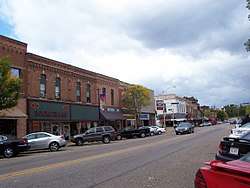 A portion of the Main Street Historic District, listed on the National Register of Historic Places
A portion of the Main Street Historic District, listed on the National Register of Historic Places.jpg) Postcard from c. 1930—1945 for Pine Lake Camp
Postcard from c. 1930—1945 for Pine Lake Camp
References
- "2019 U.S. Gazetteer Files". United States Census Bureau. Retrieved August 7, 2020.
- "U.S. Census website". United States Census Bureau. Retrieved 2012-11-18.
- "Population and Housing Unit Estimates". United States Census Bureau. May 24, 2020. Retrieved May 27, 2020.
- "History of Waupaca". Waupaca Area Chamber of Commerce. Archived from the original on August 4, 2009. Retrieved 2010-01-08.
- City of Waupaca. History of Waupaca.
- Private and Local Laws of the State of Wisconsin, 1857, chapter 264 http://sos.nmtvault.com/pdf/THEOSOS_025/images/00013923.pdf
- Private and Local Laws of the State of Wisconsin, 1862, chapter 321 http://sos.nmtvault.com/pdf/THEOSOS_025/images/00013924.pdf
- Id., chapter 365 http://sos.nmtvault.com/pdf/THEOSOS_025/images/00013924.pdf
- An Act to incorporate the city of Waupaca
- "US Gazetteer files: 2010, 2000, and 1990". United States Census Bureau. 2011-02-12. Retrieved 2011-04-23.
- "US Gazetteer files 2010". United States Census Bureau. Archived from the original on 2012-01-25. Retrieved 2012-11-18.
- "Census of Population and Housing". Census.gov. Retrieved June 4, 2015.
- "U.S. Census website". United States Census Bureau. Retrieved 2008-01-31.
- "City of Waupaca Economic Development". City of Waupaca. Retrieved 2012-08-05.
Further reading
- Dewey, Freeman Dana. Early History of Waupaca, Wis.. 1887.
External links
| Wikimedia Commons has media related to Waupaca, Wisconsin. |
- City of Waupaca
- Waupaca Area Chamber of Commerce
- Waupaca Area Public Library
- Waupaca Historical Society
- Sanborn fire insurance maps: 1885 1891 1895 1901 1909
